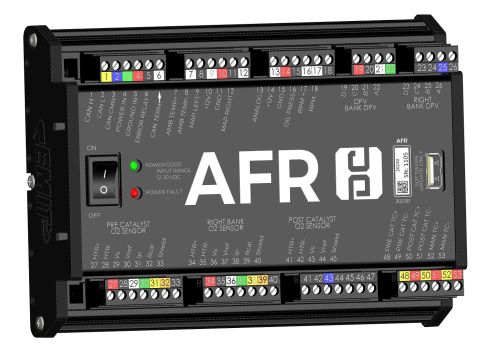AFRC Overview
See the bottom part of this page for a general overview, or the articles below for specific topics.
AFRC Documents and Guides
Minor Topics
Overview
The EMIT air/fuel ratio controller (AFRC) is available in several offerings:
| Item Number | Description | Richburn (Narrowband) Banks | Leanburn (Wideband) Banks |
|---|---|---|---|
| 20360 | AFRC-Single Richburn | 1 | 0 |
| 20235 | AFRC-Dual Richburn | 1 or 2 | 0 |
| 20230 | AFRC-Dual Rich or Leanburn | 1 or 2 | 1 or 2 |
All controllers are designed to control turbocharged or naturally aspirated carbureted stationary natural gas or propane engines for either rich-burn or lean-burn applications. The AFRC Advanced Dual is equipped to control a dual or single-bank engine with multiple options available for sensory monitoring, multi-setpoint control, and an optional control algorithm, Auto Control. The AFRC Advanced Single bank offers the same setpoint, multi-setpoint, and Auto control as the AFRC Advanced Dual but only covers single bank and narrowband applications. Unless otherwise noted, the controllers will be referred to simply as “AFRC” through the remainder of the manual.
Use of the AFR controller with an appropriate catalytic converter can result in dramatic reductions in exhaust gas pollutants, particularly Oxides of Nitrogen (NOx), Carbon Monoxide (CO), and Hydrocarbons (HC). Rich-burn NSCR catalytic converters require a constant oxygen content of less than 0.5% from the engine in order to work effectively – the AFRC provides the control needed to maintain that constant oxygen concentration. In lean burn applications, the use of the AFRC with an oxidation catalyst can result in dramatic reductions in exhaust gas pollutants of Carbon Monoxide (CO), Hydrocarbons (HC) and Volatile Organic Compounds (VOC).
The air fuel ratio of the engine is maintained by setting the appropriate oxygen sensor target setpoint that corresponds with the desired emissions reduction. The controller automatically targets and maintains the setpoint by adjusting the valve position which allows or restricts the amount gas streamed into the mixer which then richens or leans the engine. The valve is moved and stabilized using a finely-tuned Proportional Integral Derivative (PID) control loop that automatically adjusts the correct valve position quickly with little overshoot or error. If desired, multiple setpoints can be used to automatically change the target setpoint based on sensor readings through the AFRC’s mapping feature. In addition to this “Setpoint” control type, the AFRC Advanced offers optional “Auto Control” configuration for single bank or dual bank rich burn engines that can efficiently find and maintain the optimum target setpoint automatically for maximum emissions reduction. No setpoint adjustment or multi-setpoint mapping is required.
